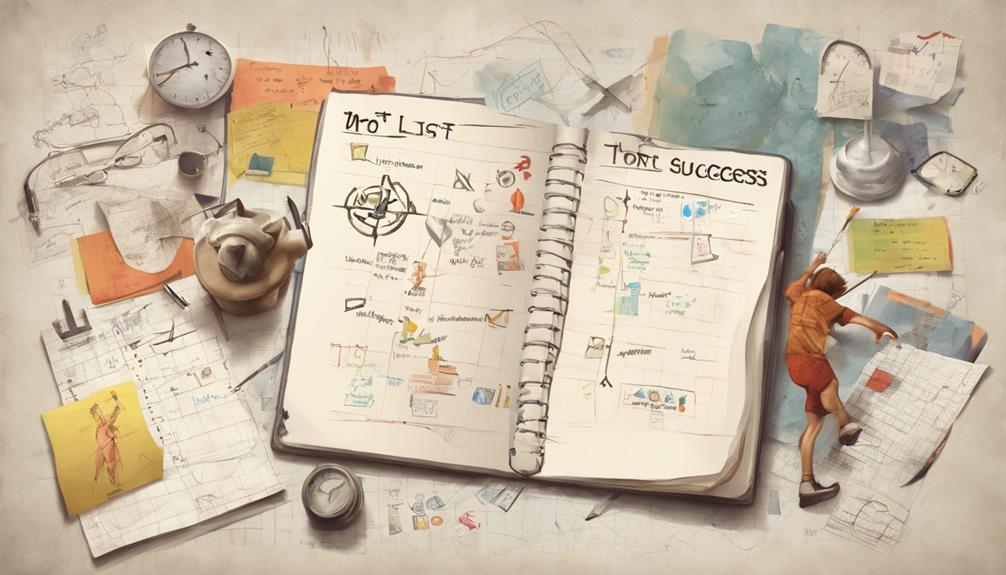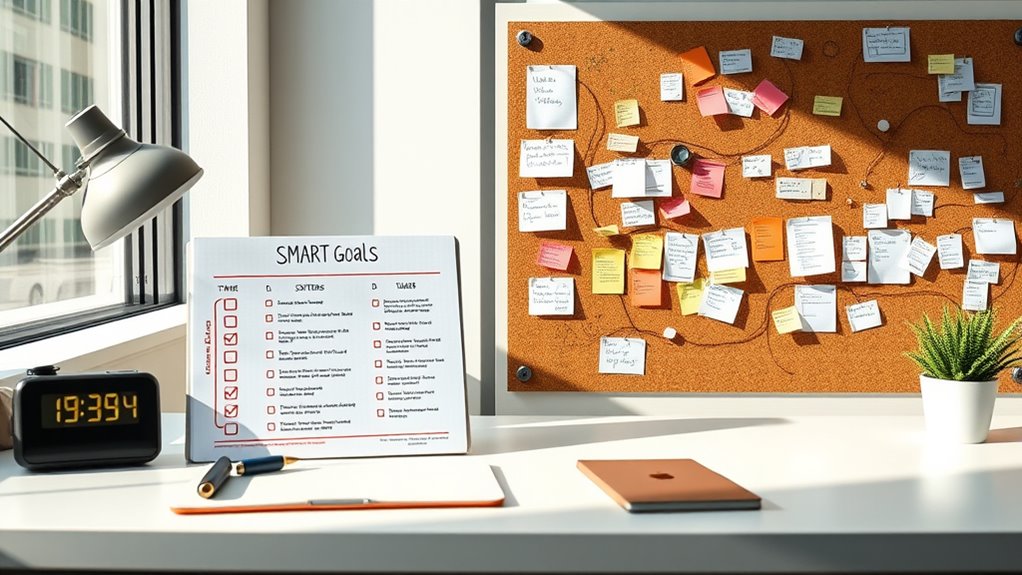Tracking your goals is essential for your success journey. It keeps you focused, motivated, and accountable. By monitoring progress and making necessary adjustments, you ensure you remain on course towards your desired outcomes. Setting SMART goals and aligning them with your values is crucial. Remember, celebrate achievements, learn from setbacks, and adapt your goals accordingly. Prioritize tasks, manage time effectively, and hold yourself responsible for progress. Tracking goals not only boosts productivity but also fosters personal growth. It's the key to unleashing your full potential and achieving long-term success. Continuously working towards your goals will lead to fulfilling results.
Key Takeaways
- Provides clarity and direction for objectives.
- Increases motivation and focus on tasks.
- Boosts productivity and enhances time management.
- Improves decision-making skills and self-discipline.
- Enhances accountability, leading to success.
Importance of Tracking Goals
Regularly tracking your goals is essential for achieving success and maintaining progress towards your desired outcomes. Setting clear goals is just the beginning; tracking them over time is what propels you forward.
By monitoring your goals, you can observe your progress, identify areas for improvement, and stay motivated to keep pushing towards success.
Tracking your goals not only helps you stay on course but also increases your sense of accountability. When you hold yourself accountable for tracking your progress, you're more likely to take the necessary actions to achieve your objectives. This accountability acts as a driving force, pushing you to stay committed to your goals even when faced with challenges.
Moreover, tracking your goals allows you to make timely adjustments as needed. By monitoring your progress, you can assess what's working well and what needs improvement, enabling you to adapt your strategies and stay on the path to success.
Effective Goal Setting Techniques

When setting goals, remember to make them SMART:
- Specific
- Measurable
- Achievable
- Relevant
- Time-bound
Utilize the PACT method for a strategic and organized approach to goal setting.
These techniques will help you clarify objectives, commit to your goals, and increase your chances of success.
SMART Goal Criteria
Implementing SMART goal criteria is essential for effective goal setting as it provides a structured framework for defining objectives and tracking progress. SMART stands for Specific, Measurable, Achievable, Relevant, and Time-bound.
Specific goals help you clearly define what you want to accomplish. Measurable goals allow you to track your progress and stay motivated. Achievable goals ensure that your objectives are realistic and attainable. Relevant goals are aligned with your long-term aspirations, keeping you focused on what truly matters. Time-bound goals provide a deadline for achieving your objectives, pushing you to work efficiently towards them.
PACT Method Utilization
Utilize the PACT method for effective goal setting by emphasizing clarity, action steps, commitment, and progress tracking. The PACT method can help you make a plan that aligns with your values and motivations.
Start by defining clear goals that drive meaningful actions through Purpose. Break down your goals into achievable steps with Action, outlining tasks and creating a step-by-step plan for successful execution.
Commitment is key – stay dedicated, persistent, and hold yourself accountable to reach your goals. Tracking your progress is essential; measure your advancement, adjust strategies as needed, and celebrate milestones along the way.
Evaluating and Adjusting Goals

Regularly assessing and fine-tuning your goals is pivotal for staying on track and making progress towards your desired outcomes. It's important to take the time to assess your goals, learning from setbacks, seeking feedback, and commemorating milestones to confirm you are on the right path. By reflecting regularly, you can evaluate what is working well and what needs adjustment, allowing for a more efficient goal-setting process.
| Significance of Evaluating and Adjusting Goals |
|---|
| Learning from Setbacks |
| Seeking Input |
| Celebrating Achievements |
| Consistent Self-evaluation |
| Modifying Goals |
Assessing your goals empowers you to adjust strategies, overcome challenges, and hasten progress. Seeking input from others offers valuable perspectives, while celebrating achievements enhances motivation. Consistent self-evaluation allows for continuous improvement, and modifying goals based on insights gained leads to successful goal attainment. Remember, flexibility and adaptability are crucial in the pursuit of your goals.
Strategies for Goal Achievement

To effectively accomplish your goals, prioritize tasks that align with your objectives and focus on high-impact activities. When setting goals, it's essential to implement strategies that maximize efficiency and productivity.
Here are some strategies you can use to enhance your goal achievement:
- Effective Time Management: Allocate your time wisely by scheduling tasks according to their importance and deadlines. This guarantees that you're consistently making progress towards your goals.
- Structured Planning: Create a detailed plan outlining the steps needed to reach your objectives. This organized approach helps you stay organized and on track throughout your goal pursuit.
- Accountability: Hold yourself accountable by tracking your progress and staying committed to completing tasks. This sense of responsibility encourages consistency and dedication towards achieving your goals.
- Flexibility and Adaptability: Remain open to making adjustments to your plan as needed. Being flexible allows you to navigate obstacles effectively and adapt to changing circumstances, ultimately increasing your chances of success in personal development and goal attainment.
Long-Term Goal Pursuit

Setting long-term goals demands persistent effort and unwavering commitment over an extended period. When you establish goals that align with your long-term vision, tracking progress regularly becomes vital.
Tracking progress not only helps you stay motivated but also allows you to make adjustments as necessary to guarantee continuous advancement.
Long-term goal pursuit is a journey that involves personal growth and development along the way. By monitoring your progress, you can celebrate the milestones achieved and remain focused on making further progress towards your ultimate objective.
Utilizing Leadership Societies

Engaging with leadership honor societies like NSLS can greatly enhance your leadership skills and accelerate your progress towards personal and professional goals. By becoming an active member of such societies, you can tap into a wealth of resources and opportunities that can help you set your goals and achieve them effectively.
Here's how working within a leadership honor society can drive and enthusiasm as you're pushing towards your goals:
- Access to Leadership Development Curriculum: NSLS offers a structured program focused on leadership development, providing you with the tools and knowledge needed to excel in your personal and professional endeavors.
- Building Problem-Solving Skills: Joining a leadership honor society can enhance your problem-solving abilities through collaboration with other members, fostering a proactive approach to goal achievement.
- Support and Accountability: Accepting a nomination to a leadership honor society can provide you with a network of like-minded individuals who can offer support, guidance, and hold you accountable as you push towards your goals.
- Tailored Strategies for Goal Setting: Utilizing strategies tailored to your work style within a leadership honor society can help you effectively set and achieve your goals, ensuring a personalized approach to success.
Benefits of Goal Setting

Achieving success is greatly enhanced through the practice of setting specific goals, as evidenced by a study showing a 42% increase in productivity attributed to goal setting.
When you set goals, you give yourself a clear target to work towards. This clarity helps you track progress effectively and measure success along the way. By setting specific goals, you increase your chances of achieving success by 90%. Having these concrete objectives provides you with a sense of direction and purpose, which in turn boosts your motivation and focus.
When you align your goals with your values, you not only stay motivated but also experience greater satisfaction and fulfillment in life. In addition, effective goal setting enhances self-accountability and personal growth.
Frequently Asked Questions
Why Is Tracking Goals Important?
Tracking goals is essential for your success. It provides clarity on progress and areas needing improvement, boosts accountability, motivates you by showcasing achievements, helps in spotting trends for strategy adjustments, and ultimately leads to higher success rates.
Why Is Measuring Goal Progress Important?
When measuring goal progress, you gain clarity on your journey, paving the way for success. It's like painting a map of achievements and challenges, guiding you towards victory. Keep tracking to reach your destination!
Why Is Goal Setting Important for Success?
Goal setting is vital for success as it provides direction, focus, and motivation. Setting SMART goals enhances productivity and personal growth. Prioritizing tasks, measuring progress, and aligning values drive success and foster self-confidence.
What Is the Science Behind Goal Tracking?
So, what's the deal with goal tracking? Well, let me tell you. It's all about monitoring progress, boosting accountability, and activating your brain's reward system to keep you on track toward success. Effective goal tracking involves setting specific, measurable, achievable, relevant, and time-bound (SMART) goals, regularly checking in on your progress, and making adjustments as needed. By consistently tracking your goals, you can identify any obstacles or challenges that may arise and find solutions to overcome them. This proactive approach helps to increase your motivation and momentum, ultimately propelling you closer to achieving your desired results.
Conclusion
By tracking your goals, you're actively shaping your future, setting yourself up for success, and achieving your dreams.
Remember, effective goal setting techniques, regular evaluation and adjustments, and strategic planning are key to reaching your aspirations.
Stay focused, stay motivated, and keep pushing yourself to new heights.
The road to success is paved with determination, perseverance, and a clear vision of what you want to achieve.
You've got this!





